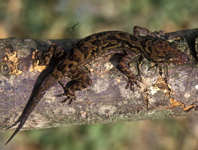Abstract
We describe a new species of Leptolalax from northern Vietnam. Leptolalax botsfordi sp. nov. is distinguished from its congeners by a combination of (1) supra-axillary and ventrolateral glands present; (2) dark brownish red ventral surface with white speckling; (3) medium body size for the genus (29.1–32.6 mm in 7 adult males, 30.0–31.8 mm in 2 females); (4) black markings on the flanks absent; (5) toes with rudimentary webbing and weak lateral fringing; (6) large pectoral glands (1.1–1.9 mm; 4–6% SVL) and femoral glands (2.4–4.3 mm; 7–14% SVL); and (7) an advertisement call with a dominant frequency of 2.6–3.2 kHz (at 14.0º C). At present, the new species is known only from upper montane forest between 2,795–2,815 m elevation on Mount Fansipan, Hoang Lien National Park. To our knowledge, Leptolalax botsfordi sp. nov. occurs at higher elevations than any other species in the genus. If L. botsfordi sp. nov. is truly restricted to a narrow, high-elevation band, it is likely to be particularly vulnerable to the effects of climate change. The new species also faces the immediate threat of habitat degradation and pollution due to tourist activity.

